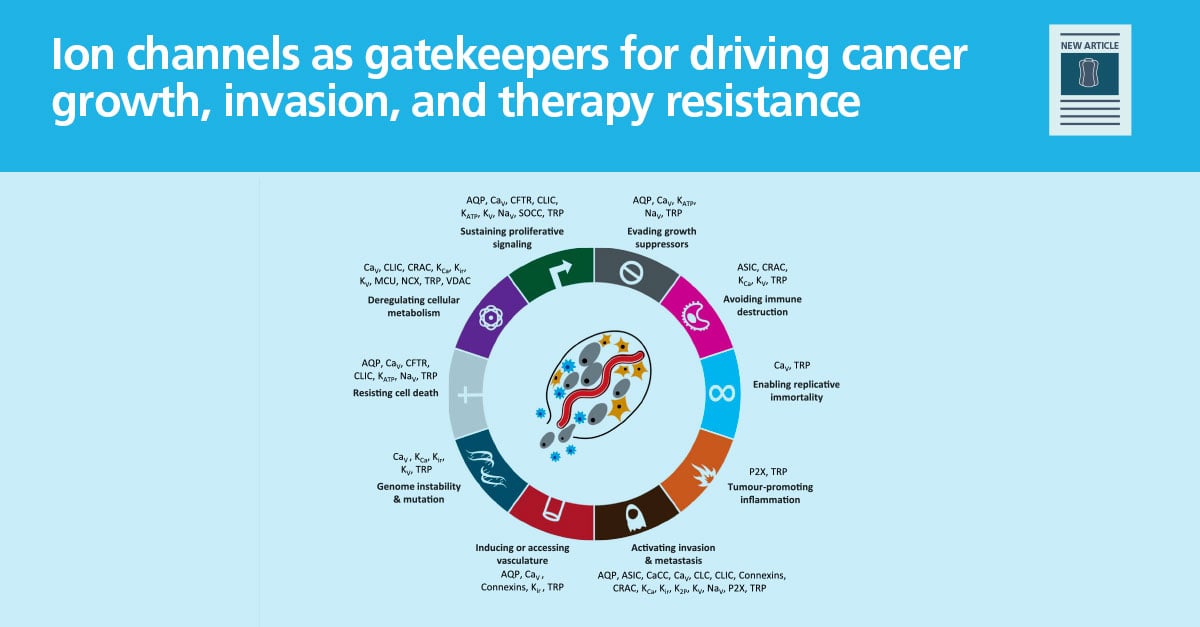
Charged for growth: Ion channels in cancer’s arsenal
Ion channels are increasingly recognized for their role in cancer development, progression and hence have significant potential as therapeutic targets. Their dysregulation contributes to hallmark cancer processes, including uncontrolled proliferation; evasion of apoptosis; metastasis; and, the maintenance of a supportive tumour microenvironment (TME).
Ion channels as gatekeepers of cancer progression: regulating growth, invasion, and metastatic potential
- Voltage-gated sodium channels (VGSC), are implicated in several cancers, including breast, prostate and lung cancers. VGSC, such as Nav1.5 and Nav1.7 (Pukkanusut et al, 2024) are often upregulated in cancer cells and contribute to enhanced metastatic potential. These channels facilitate the invasion of cancer cells by promoting processes like the epithelial-mesenchymal transition (EMT) and the remodelling of the extracellular matrix (ECM). Nav1.5, for example, has been shown to drive the metastatic behaviour of breast cancer cells by increasing their invasiveness and motility through enhanced ECM degradation (Leslie et al., 2024).
- Potassium channels, particularly the voltage-gated Kv family, also play a key role in cancer biology (Xie et al., 2023). These channels modulate membrane potential, influencing cell cycle progression and oncogenic signalling pathways such as PI3K/AKT and MAPK. Hyperpolarization driven by potassium channels supports the G1/S transition in the cell cycle, promoting proliferation: a key feature of cancer. The overexpression of Kv channels in cancers such as glioblastoma and pancreatic cancer correlates with increased tumour growth and poor prognosis.
- Calcium channels, including voltage-gated (Cav) and store-operated calcium channels (SOCs), are crucial in cancer-related signalling pathways (Tajada & Villalobos, 2020). Dysregulation of Ca2+ homeostasis through these channels influences processes like cell migration, invasion, and resistance to apoptosis. For instance, increased Ca2+ influx via these channels can activate calpains and other metastasis-associated pathways, driving epithelial-mesenchymal transition (EMT) and promoting metastatic behaviour.
- Chloride ion channels, (ClC; including intracellular CLICs) also modulate the TME: ClC, CLIC and TMEM16A, contribute to the acidic TME by regulating intracellular pH and cell volume. The resulting acidic environment supports tumour survival, invasiveness and resistance to chemotherapy (Kim et al., 2022).
Therapeutically, targeting these ion channels holds promise. For example, blocking VGSC like Nav1.5 has been shown to reduce metastasis (Badwe et al., 2023), while inhibiting Kv and Cav channels may decrease proliferation and enhance apoptosis. Additionally, targeting channels that regulate the TME could improve the efficacy of conventional treatments.
In conclusion, ion channels are critical players in cancer biology, influencing tumour growth, metastasis and treatment resistance. Their dysregulation contributes to hallmark cancer processes (Hanahan, 2022) and their diverse roles make them attractive targets for developing novel anti-cancer therapies that could improve patient outcomes.
